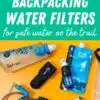The Best Backpacking Water Filters and Purifiers of 2024
This post may contain affiliate links.
We cover everything you need to know about backpacking water filters and water purifiers: how the different methods work, what features to consider, and which systems are best for different circumstances.
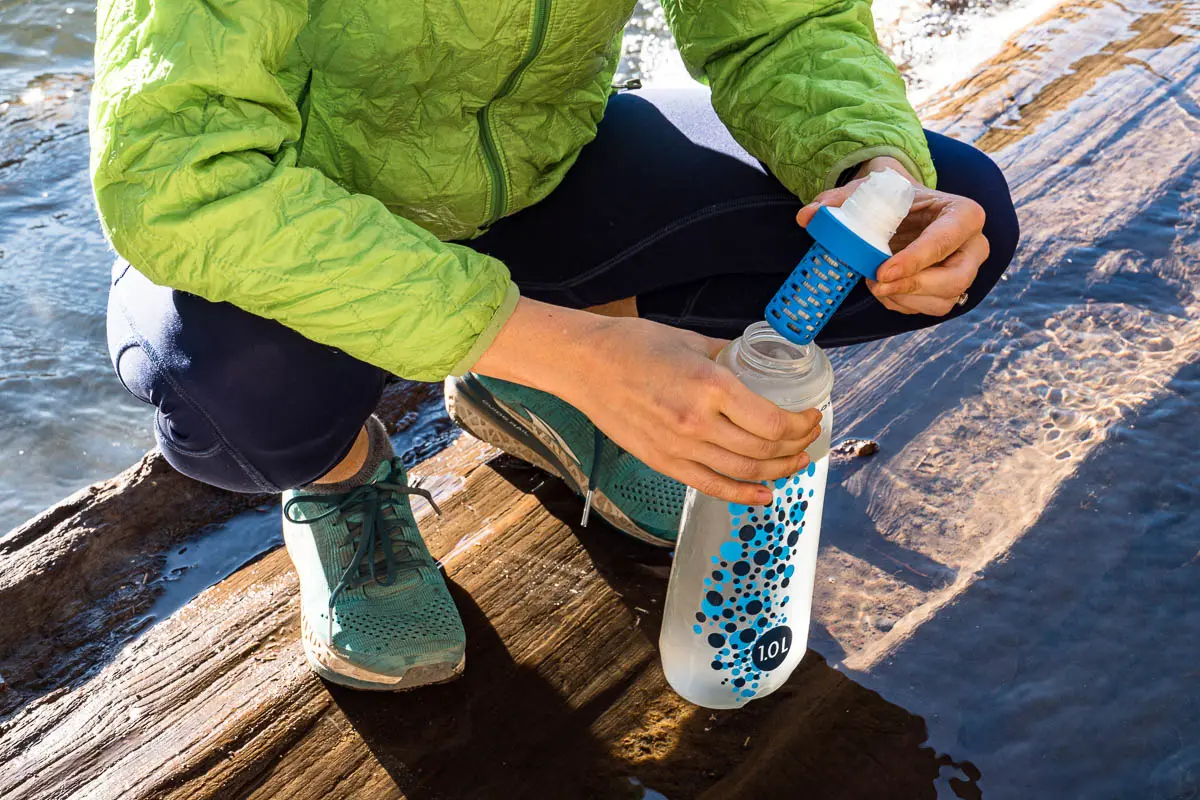
Having access to clean water is critical for any backpacking trip or long hike.
While it might appear that the lakes and rivers you hike past are crystal clear, it’s important to properly treat ALL water before drinking it.
Even in the most pristine alpine stream has to potential to contain an array of microscopic pathogens that can make you seriously ill.
Giardia, Cryptosporidium, and E.coli are no joke and have the potential to absolutely ruin your backpacking trip.
Thankfully, there are a lot of water treatment options available so you can turn any water source into safe drinking water. However, this also means it can take a lot of research to find the right system for your personal circumstances. Starting with: the different methods (physical, chemical, or UV), the different designs (gravity, squeeze, pump), flow rate, maintenance schedule. You get it, it’s a lot to sort through.
But, you’re in luck because we’ve done all the hard work for you! We’ve reviewed all the different models and methods, tested out the best products, and compared them against one another. And then we distilled all that info down, so you can make best decision relatively quickly.
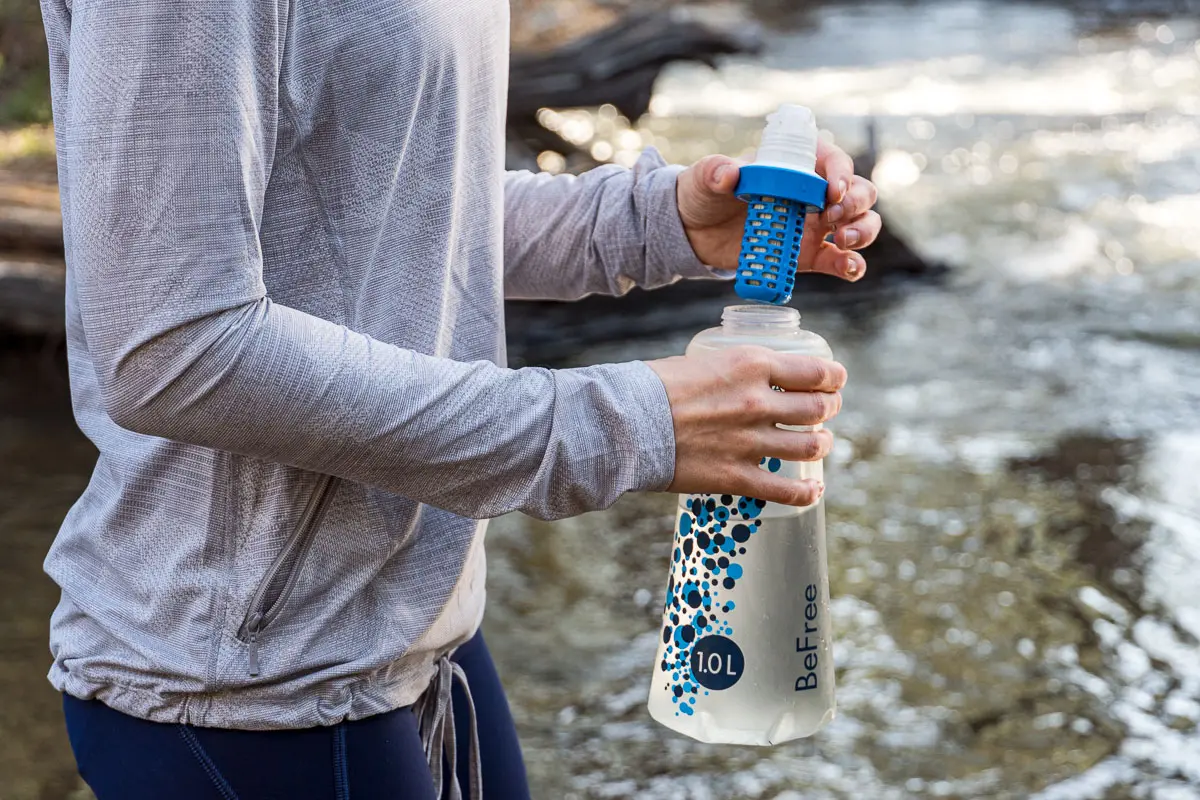
Top Recommended Backpacking Water Filters
Best backpacking water filters
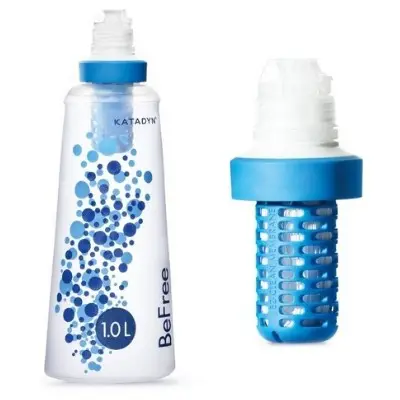
Best Lightweight Filter
Katadyn BeFree
Type: Squeeze
Weight: 2.3 oz (with 1L flask, 1.2 oz filter only)
Claimed Flow Rate: 2L/min
Filter Life Span: 1,000L
Removes: Bacteria (99.9999%) & protozoa (99.99%)
What We Like: We really like the versatility of the Katadyn BeFree system, which allows you to drink from the included flask using the filter cap, squeeze water through into a clean water bottle, or rig it up as a gravity filter.
The BeFree has a super fast flow rate (although, like all filters, it decreases over time). We find that because of the great flow rate, it’s super easy to drink from the cap–it doesn’t feel like you need to put a lot of effort into sucking water through, and you don’t need to exert a ton of pressure on the flask to filter water into a cook pot or another water bottle.
We also love the super-simple cleaning process. No backflushing, no extra cleaning equipment, just swish the filter around in clean water and it’s good to go!
What We Don’t Like: Personally, we found that it took a little while for the plasticy taste to go away from the included flask. Cleaning the flask a few times before initial use will help, but it will take a couple of cycles for that slight off-taste to fully go away.
Initially, the BeFree has one of the fastest flow rates of the water filters currently available. However, the flow rate does decrease over time. All filters have this issue, so it’s not unique to the BeFree, but it’s worth keeping in mind if it’s the main reason you’re considering this filter over others. Katadyn recommends cleaning the filter by shaking/stirring it in clear water after every 5 liters filtered for best performance.
While we haven’t personally had this issue, some online reviewers think the flask isn’t durable enough. If that’s a concern, you can buy just the filter cap and purchase a more durable 42mm bottle to pair it with, like the Hydrapak Flux. Then again, we’ve knocked ours around and have never sprung a leak.
Bottom Line: The Katadyn BeFree has been our go-to filter for the past few seasons for backpacking, hiking, and trail running. You just can’t beat its ease of use and weight!
Where to buy:
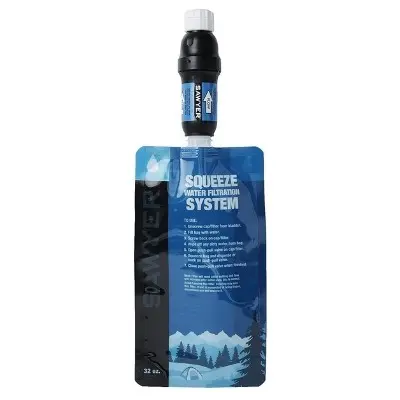
Thru-Hiker Favorite
Sawyer Squeeze
Type: Squeeze
Weight: 3.5 oz (filter only)
Claimed Flow Rate: 1.7L/min
Filter Life Span: 378,000L
Removes: Bacteria (99.99999%) & protozoa (99.9999%)
What We Like: Year after year, the Sawyer Squeeze appears at the top of the list for thru-hikers as a favorite filter. This is another squeeze-style water filter that screws onto a water bottle or a soft pouch that comes with the filter.
Like the BeFree above, the Squeeze can use to drink directly from a water bottle, squeezed into another bottle, or used as a gravity filter.
Best of all, it has a lifetime warranty on the filter. So no need to keep track of how many liters you have put through it.
What We Don’t Like: The Sawyer Squeeze (like many filters) needs to be backflushed to maintain its flow rate. As sediment gets lodged in the fibers, the water can reduce to a trickle. How quickly this happens depends on the water sources you draw from–pristine lakes and rivers are less likely to be an issue even with frequent use, but we have gone on trips where we needed to backflush after only two days when filtering water with lots of fine sediment in the desert.
The good news is that the syringe included with the Squeeze is very effective at restoring the flow rate. The downside is that the syringe itself adds an ounce to the advertised weight, and it’s about the size of the filter itself, taking up room in your pack if you need it on trail during longer trips.
While their use is optional, we also really don’t like the water collection bags included with the Sawyer Squeeze. This is primarily due to the size of the mouth, which makes scooping up water a bit of a tedious task.
When using it as a squeeze filter (vs attached to a bottle), we’d prefer to use a bag like the CNOC 28mm Vecto bag (2.75oz) that has a wide top opening which makes collecting water super easy and is compatible with the Squeeze. We’ve also read many reviews online that the Sawyer Squeeze bags are prone to tearing (we have not encountered this personally, though that could be because we so rarely choose to use them!).
Bottom Line: The Sawyer Squeeze has been a trail favorite for years. It’s light, inexpensive, durable and will last essentially forever if cared for properly.
Where to buy:
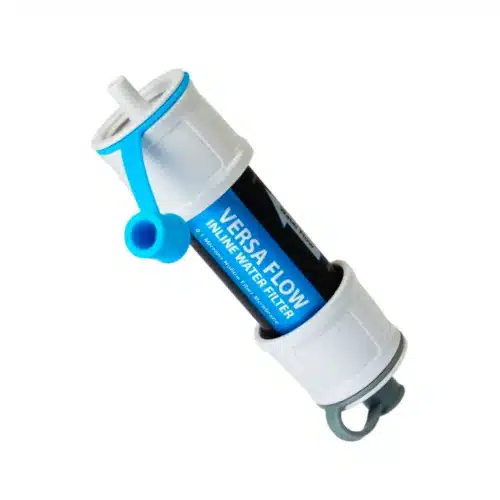
Most Versatile Lightweight Filter
HydroBlu Versa Flow
Type: Squeeze / Inline / Gravity
Weight: 2 oz
Claimed Flow Rate: 1L/min
Filter Life Span: 378,000L
Removes: Bacteria (99.9999%) & protozoa (99.9%)
What we like: The HydroBlu Versa Flow is a versatile, lightweight filter that has a lot of great features. It can be used as a squeeze filter, like the Sawyer and the BeFree, but can also be used as an inline filter without any extra parts (attaching it to your hydration bladders’ hose and assuming you are OK making your bladder a “dirty water bag”), or as a gravity filter.
The Versa Flow can also be screwed onto the top of a water bottle with 28mm internal threading (most water/soda bottles have 28mm threading). That said, this filter specifically does not work with the ubiquitous Smartwater bottle, which has slightly thicker threads that are incompatible with the Versa Flow.
What sets the Versa Flow apart from similar filters is that the water can flow through it in either direction, and it has threading on both ends of the filter (the Sawyer filters only have it on the inlet side). What this means is that the Versa Flow can be backflushed without the need of a syringe or additional coupling, making maintaining the flow rate much easier while on the trail.
It’s worth noting that while the claimed flow rate looks much slower than other filters, when you use it as a squeeze filter, vs as a passive gravity filter, we have found that the flow rate is basically the same as the Sawyer Squeeze and the Katadyn BeFree.
What we don’t like: There is no sports cap option for the Versa Flow, which makes drinking directly through it kind of annoying. Think of it more like drinking through a straw, versus drinking from a standard water bottle cap. This is likely an individual preference, and it doesn’t impact the way it functions as a squeeze, inline, or gravity filter.
Another small consideration (this could be a pro or a con, honestly) is that the Versa doesn’t come with a water collection bag or flask. You’ll need to pair the Versa Flow with a vessel to collect water from the source. The cheapest option is to use a second lightweight water/soda bottle that can be used as a squeeze bottle. Or, use a soft flask or bag—our personal favorite option is the CNOC 28mm Vecto bag (2.75oz), which has a wide top opening which makes collecting water super easy.
Bottom Line: The HydroBlu Versa Flow is a solid filter that can be used with a water bottle, as a squeeze or gravity filter, or inline with a hydration bladder, and is easy to maintain on the trail.
Where to buy:
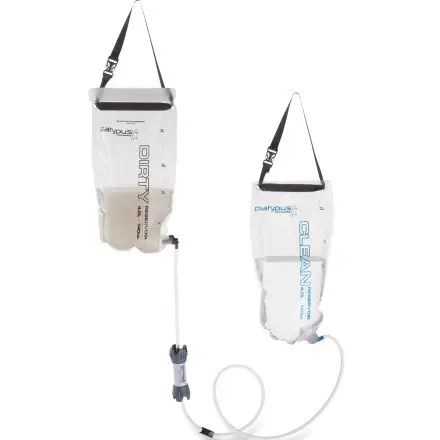
Best Gravity Filter for Groups
Platypus GravityWorks
Type: Gravity / Reservoir
Weight: 11.5 oz
Claimed Flow Rate: 1.75L/min
Filter Life Span: 1,500L
Removes: Bacteria (99.9999%) & protozoa (99.9%)
What we like: The Platypus GravityWorks is a (you guessed it) gravity water filter system—which means all the hard work is taken care of by gravity while you sit back and wait for your clean water to be ready.
Given its larger capacity, this is a great filter system for groups small and large, but perhaps a little overkill for solo backpackers. Though we’ve moved on to the BeFree for most backpacking trips, Michael and I used the GravityWorks system on our JMT thru-hike. We’ve gotta say it was really nice to only have to walk down to our water source once and be able to grab enough water to take care of dinner, breakfast, and our initial water bottle fill for the next day—especially when mosquitoes were abundant.
What we don’t like: This system is a bit cumbersome to use while hiking during the day. It has to be assembled and rigged up each time, and we certainly never needed to filter 4L of water at a time any time other than at camp.
Additionally, it’s on the heavy side and is not as compact as the other filters on this list. It’s also one of the most expensive filter systems.
Bottom Line: The Platypus GravityWorks is a great large-capacity water filter with a fast flow rate. We still have it in our gear closet for backpacking with groups of three or more simply because it makes the chore of filtering water a cinch.
Where to buy:

Best Pump Purifier
LifeSaver Wayfarer Purifier
Type: Pump
Weight: 15.4 oz
Claimed Flow Rate: 1.4L/min
Filter Life Span: 5,000L
Removes: Bacteria (99.9999%), viruses (99.999%), and cysts (99.99%)
What we like: New for 2023, the LifeSaver Wayfarer earns a place on our list because it brings an affordable pump-style purifier to the market. Previously, you’d have to shell out $300+ for a purifier like the MSR Guardian — but the Wayfarer costs just a hair over $100.
A replaceable activated carbon disk can be added to the Wayfarer to remove heavy metals, chemicals, and help improve the taste of the water. These disks are good for 100L before needing to be replaced, and aren’t required for the purifier to remove microbiological contaminants.
What we don’t like: The Wayfarer isn’t without it’s compromises. At nearly a pound, it’s the heaviest water treatment option on this list. We’d like to note that online, LifeSaver claims this filter is 11.4oz—which is technically true of the filter unit itself. But, you need the hoses in order for the filter to be useable, which adds 4 oz. So, the total weight of all required parts came out to 15.4 oz when we weighed it.
However, the biggest drawback to the Wayfarer is the continual maintenance required to keep the filter cartridge in working order. As per the user manual, the filter membrane must not be allowed to dry out during storage, otherwise it will damage the fibers and render the pump inoperable. To keep the filter wet, but prevent the water from getting funky and stagnant, it is recommended that clean water be flushed through the filter every month. This is a lot of ask of a user, especially during in the off-season. If the filter cartridge dries out to the extent of needing to be replaced, the replacements cost ~$65 a pop.
It’s worth noting that this is not unique issue to the Wayfarer–other purifiers like the MSR Guardian have the same demanding storage requirement.
Nevertheless, it makes it a much higher-maintenance device than a typical water filter, so we’d really only recommend it if you need a purifier, not simply a filter.
Bottom Line: If you are hiking in an area where you need the ability to remove viruses from water, the Wayfarer is an affordable pump-style purifier that can also remove heavy metals and chemicals when you add an activated carbon filter.
Where to buy:
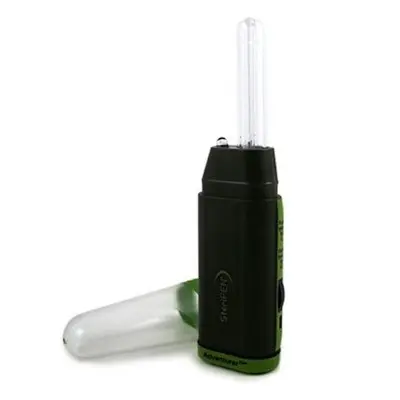
Best UV Purifier
Katadyn Steripen Adventurer Opti
Type: UV Light
Weight: 3.8 oz (with batteries)
Time to Purify: 1.5min/L
Battery Life: up to 50L
Bulb Lifespan: 8,000L
Eliminates: 99.9% of bacteria, protozoa, viruses
What we like: The Steripen Adventurer Opti works by submerging a UV lamp in your bottle of water and stirring for 90 seconds as it deactivates the DNA structures of bacteria, protozoa, and viruses.
This is a super easy, lightweight, and relatively cheap way to purify water. There are no moving parts, no backflushing to be done, and no worry about it breaking if you encounter freezing temperatures.
The rate at which you can purify water will never slow over time since there’s no filter to get clogged up with use.
What we don’t like: The Adventurer Opti can only fit in wide-mouthed bottles (minimum diameter of 1.75″) like a Nalgene. The Ultra is a different model that can be used with a standard water bottle–unfortunately, it’s heavier (5oz) and relies on a USB charge (this could be a plus or minus based on preference).
This isn’t necessarily a “con”, but it’s definitely something to be considered: it’s critical to pre-filter your water using a bandana or buff so there are no particles in the water. If a virus or bacteria is hanging out on the backside of a floatie, the UV light won’t hit it and it will be allowed to reproduce freely.
Another consideration to weigh is battery management. The Adventurer Opti uses replaceable batteries, so you’ll need to monitor lifespan and plan accordingly. If you’re thru-hiking, it might be difficult to find CR123 batteries on trail. If you’d rather use a USB rechargeable device, the Ultra is an option instead.
Bottom Line: We have used the Adventurer Opti and think it’s great as a lightweight water purifier for backpacking and hiking trips on high-impact trails where viruses may be present.
Where to buy:
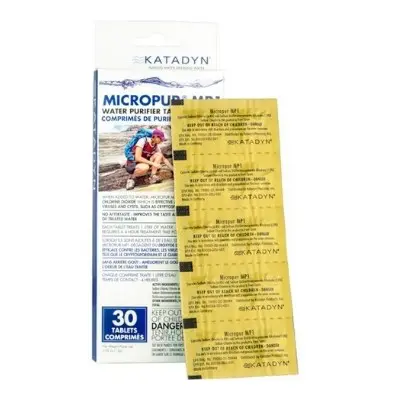
Best Backup Water Treatment
Micropur Tablets
Type: Chemical
Weight: .9 oz for 30 tablets
Time to Purify: 4 hours
Eliminates: Bacteria, protozoa, viruses
What we like: Micropur tablets are a simple and efficient way of purifying water–just drop a tablet into a liter of water and let it do its thing. There are no moving parts, no batteries, no backflushing… it’s super low maintenance and nearly fail-proof.
At less than an ounce for 30 tablets and taking up almost no space in our packs, it’s a no-brainer for us to throw a handful into our first aid kit just in case. We’ve personally had filters accidentally freeze overnight in the backcountry, and have had friends whose systems failed, so having these on hand really offers peace of mind.
What we don’t like: As a primary treatment method, the cost of using Micropur Tablets could really add up–at $15 for 30 tablets, you’re looking at spending around $3 a day to treat water while backpacking (assuming you need 1L of water for cooking, and 4-5L for drinking).
This is also the slowest method of treating water on this list. It takes 15 minutes to kill bacteria and viruses, 30 minutes to kill giardia, and 4 hours to eliminate Cryptosporidium. It is passive time, but it does require some patience and planning!
Some users report that Micropur Tablets leave a chemical taste in the water–which makes sense since that’s exactly what it is, but it’s something to keep in mind.
Bottom line: Micropur Tablets are great to have in your pack as a backup in case your main system fails.
Where to buy:
Comparing the best water filters and purifiers
| Filter | Weight | Flow Rate | Lifespan | MSRP |
|---|---|---|---|---|
| Katadyn BeFree (filter and flask) | 2.3 oz | 2L/min | 1,000L | $49.95 |
| Katadyn BeFree (filter only) | 1.2 oz | 2L/min | 1,000L | $26.95 |
| Sawyer Squeeze | 3.5 oz | 1.7L/min | 378,000L | $40.95 |
| HydroBlu Versa Flow | 2 oz | 1L/min | 378,000L | $22.95 |
| Platypus GravityWorks 4L | 11.5 oz | 1.75L/min | 1,500L | $134.95 |
| Lifesaver Wayfarer Purifier | 15.4 oz | 1.4L/min | 5,000L | $104.95 |
| Steripen Adventurer Opti | 3.8 oz | 1.5min/L | 8,000L (bulb) | $119.95 |
| Micropur MP1 Tablets | .9oz (30 tablets) | 30L | $15.95 |
Why trust us?
We’ve been backpacking for over 15 years, and have filtered and purified hundreds of liters of water in the backcountry using a wide variety of products. Our recommendations are based on first-hand knowledge of the individual products as well as a broader understanding of how these products will be used in real-world backpacking environments.
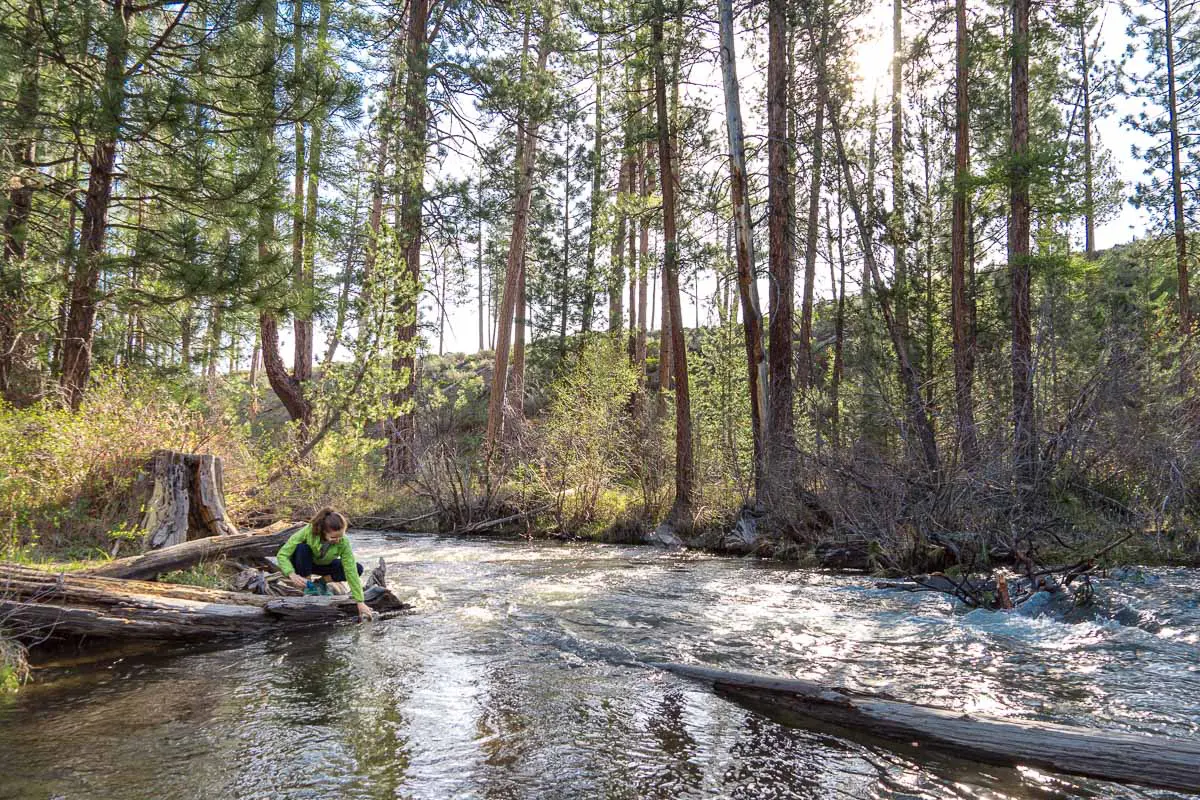
When do you need a water filter?
You should always use a water filter when backpacking or hiking. Even if the water source looks to be perfectly clear, there is no way of knowing what’s going on upstream, far beyond your sight. Perhaps livestock defecated in the middle of the stream, an animal carcass has been washed into the water, or a recent rainstorm has unearthed a hiker’s poorly dug cathole.
While the overall likelihood of you getting sick might be low, the consequences if you do get sick can be quite severe.
Our take: I have personally suffered from rapid dehydration on a few occasions, once from contaminated water in Mexico City. I went from perfectly normal to writhing on the ground in less than 8 hours. If I had been in the backcountry, unable to walk, burning through my limited food supplies, and without access to a bathroom, I would have been smashing the SOS button on my inReach satellite messenger. It is not worth the risk. –Michael
Types of waterborne pathogens
Any water source can potentially contain hazardous waterborne pathogens. In the backcountry, even pristine-looking water—like a crystal clear alpine stream—can be contaminated by humans, livestock, or local wildlife further upstream.
Pathogens can rapidly multiply inside the human body, so even ingesting a very small amount can quickly lead to issues. Below are the most common waterborne pathogens found in the backcountry.
Protozoa include Cryptosporidium parvum and Giardia lamblia. Protozoa have hard cyst-like outer shells that make them resistant to certain generic chemicals, like chlorine and iodine. Thankfully, they are relatively large (as far as pathogens go) which makes them fairly easy to filter out.
Bacteria include Salmonella, Campylobacter, Escherichia coli (E. coli), etc. These are just a few of the many different types of bacteria that can be harmful if ingested. Again, thankfully bacteria are medium-sized, making them relatively easy to filter out.
Viruses include Hepatitis A, rotavirus, and norovirus. Viruses are much smaller than protozoa and bacteria, making them very difficult to filter out. Water filters do not filter viruses—the exception being filter-purifiers. However, viruses typically need to come from a human source (e.x. feces), so the likelihood of water containing a virus in remote backcountry locations in the US is very low.
While the pathogens listed above affect the human body in different ways, the most common symptoms are stomach ache, diarrhea, and vomiting. This combination can lead to extreme dehydration within a matter of hours.
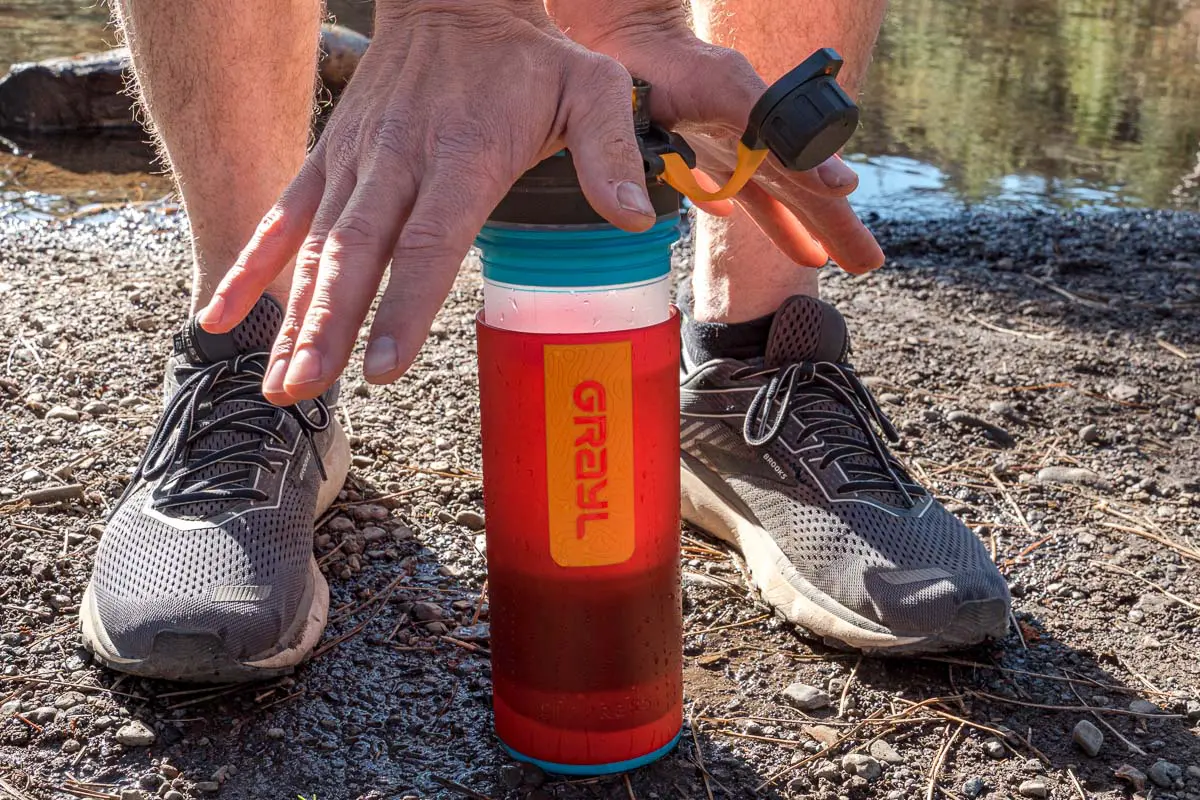
Water filter vs. water purifier
While we often refer to them broadly as “water filters”, there’s a very important difference between water filtration and water purification.
Water filtration systems remove protozoa and bacteria—but water filters do not remove viruses. Most water filters physically filter out pathogens using various mechanical methods like a hollow fiber membrane.
Water purification systems will remove viruses in addition to protozoa and bacteria. Water purification can be achieved through advanced physical methods like ion exchange and charcoal filters, advanced hollow fibers, UV light, and chemical means.
So, which one do you need?
In backcountry areas where the likelihood of human contamination is very low, we usually will just use a filter.
In areas where there’s a higher chance of human contamination, such as super popular canyons with only one slow-moving source of water, you may want to consider using a purification system to treat water.
Types of backpacking water filters
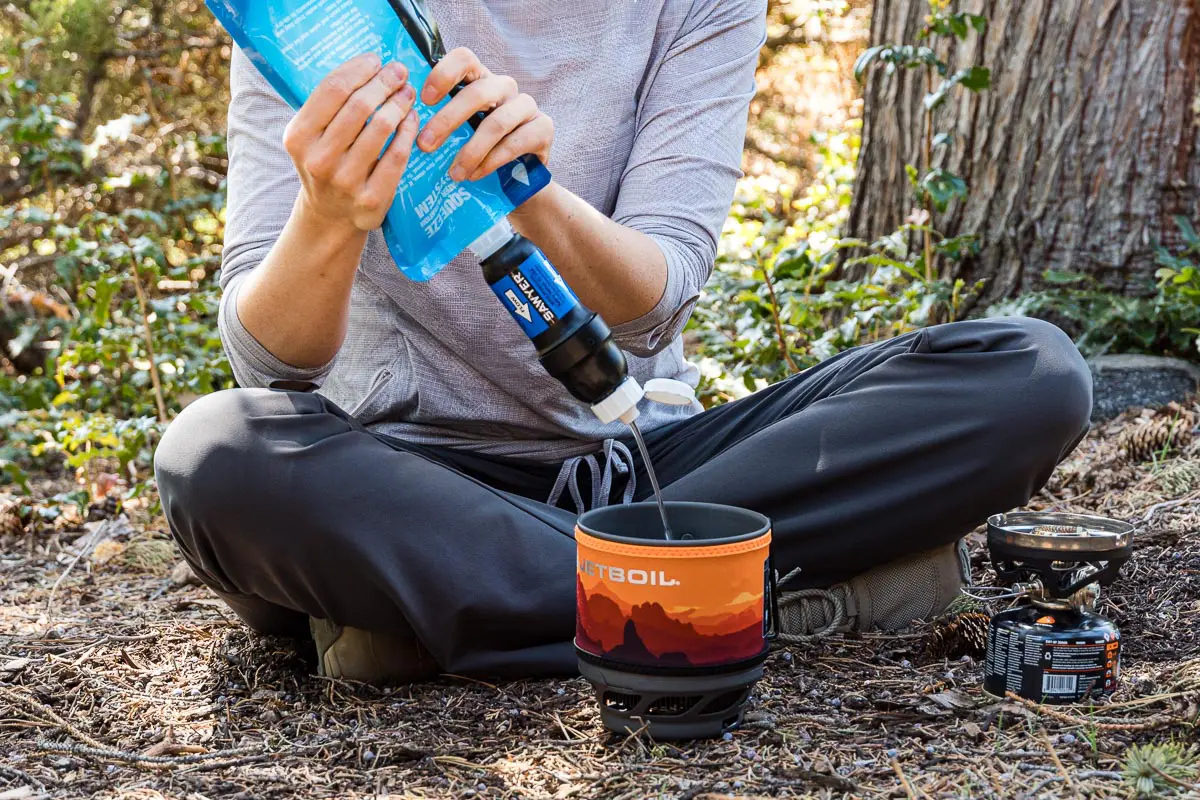
Squeeze water filters
Squeeze filters are made from hollow fiber membranes and are most often paired with a soft bag or flask that you fill with dirty water. Then, you squeeze to force the water through the filter into a clean bottle or reservoir, your cookpot, or directly into your mouth. These backpacking filters tend to be lightweight, inexpensive, and have no mechanical parts to worry about.
They do, however, tend to have a decreased flow rate over time which, with certain filters, can be partially addressed by backflushing to clean the filter. Pre-filtering water that is cloudy or contains sediment using a bandana or buff can help prevent the decrease in flow rates.
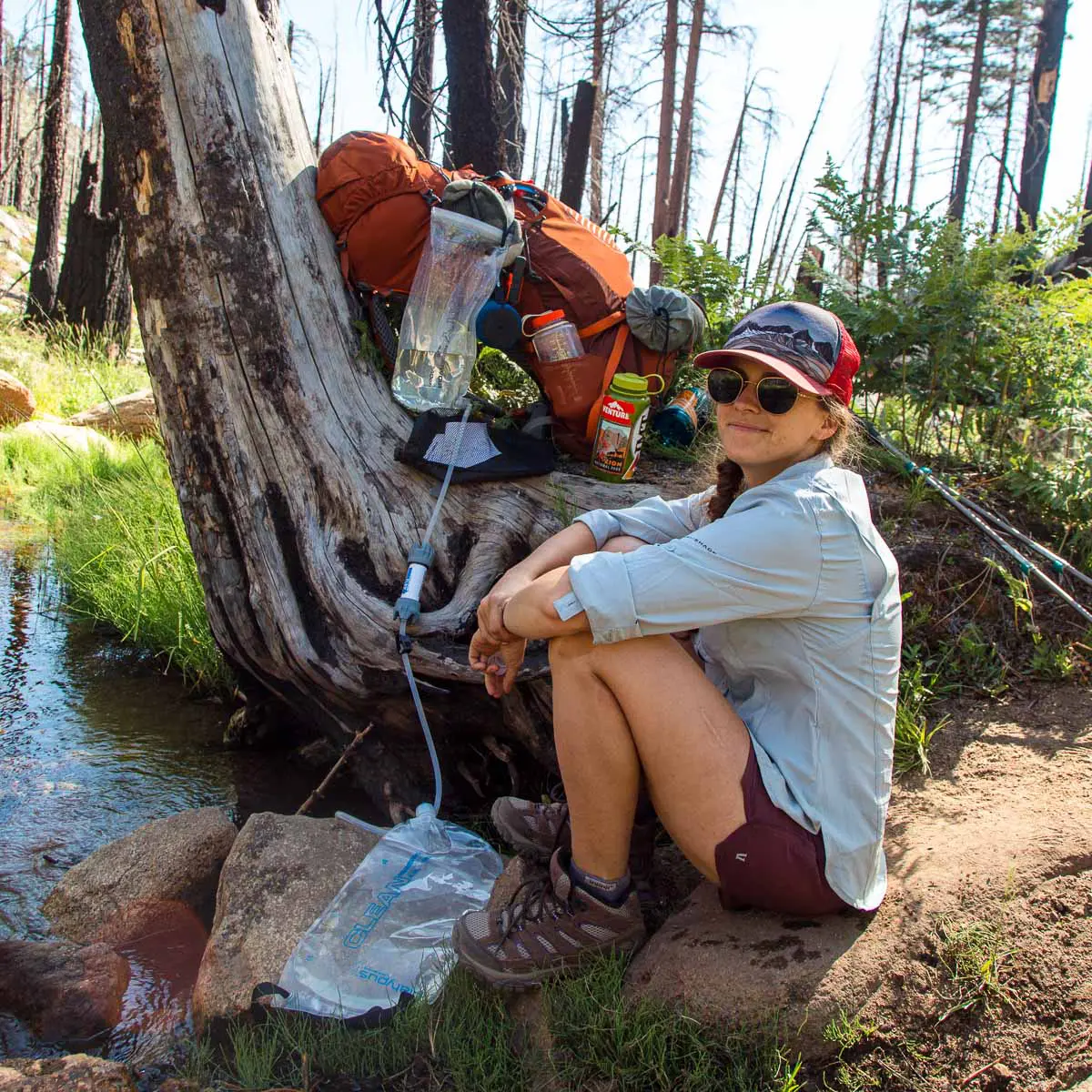
Gravity filters
Gravity filters use, well, gravity to pull water from a “dirty” reservoir bag hung on a tree (or held up high) through a hollow fiber filter and into either a clean water reservoir or bottle.
These filter systems tend to be a bit heavier than squeeze systems due to the reservoirs, hanging straps, and tubes, but they are a great way to quickly filter large quantities of water with minimal effort, making them best for groups or base camping.
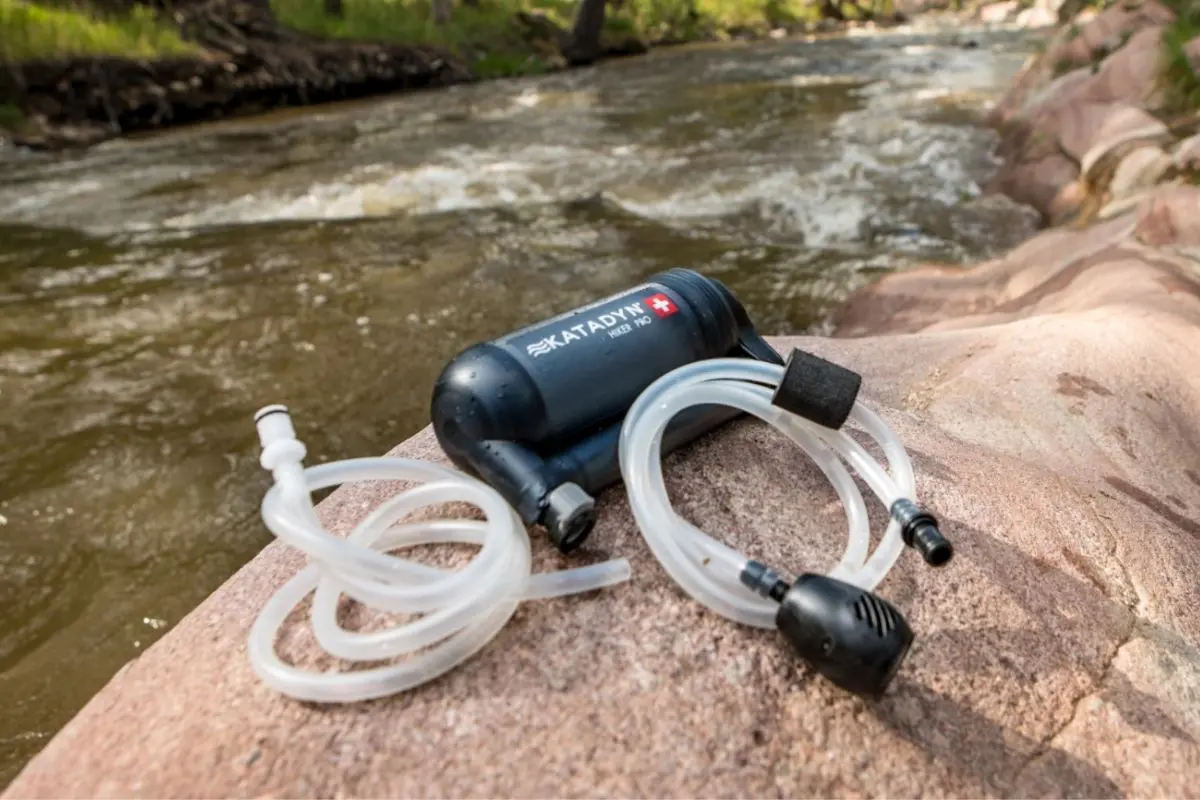
Pump filters
Pump filters use a hand pump to force water through a hollow or glass fiber filter. You pump water directly from the source, dropping a hose into the water and then hand pumping until you have all the water you need. This does means you need remain at the water source for the duration of the time it takes you to filter–a pain if it’s super buggy! Pumps are also heavier than most other filter systems.
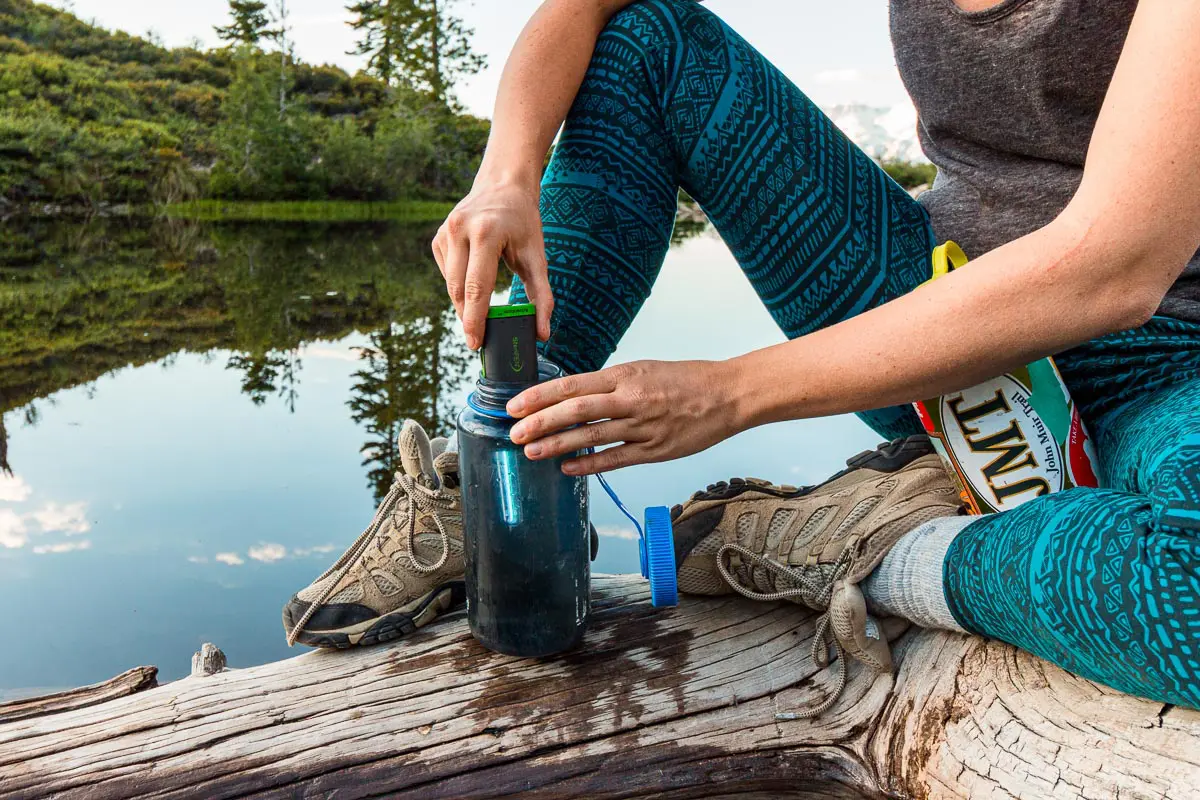
UV light
UV light purifiers use a UV bulb to destroy the DNA/RNA of bacteria, protozoa, and viruses, making them unable to reproduce and in effect, killing them. It is critical to pre-filter your water using something like a bandana or buff so there are no particles in the water. If a virus or bacteria is hanging out on the backside of a floatie, the UV light won’t hit it and it will be allowed to reproduce freely. While lightweight, UV purifiers rely on batteries (either replaceable or USB rechargeable), which should be taken into consideration.
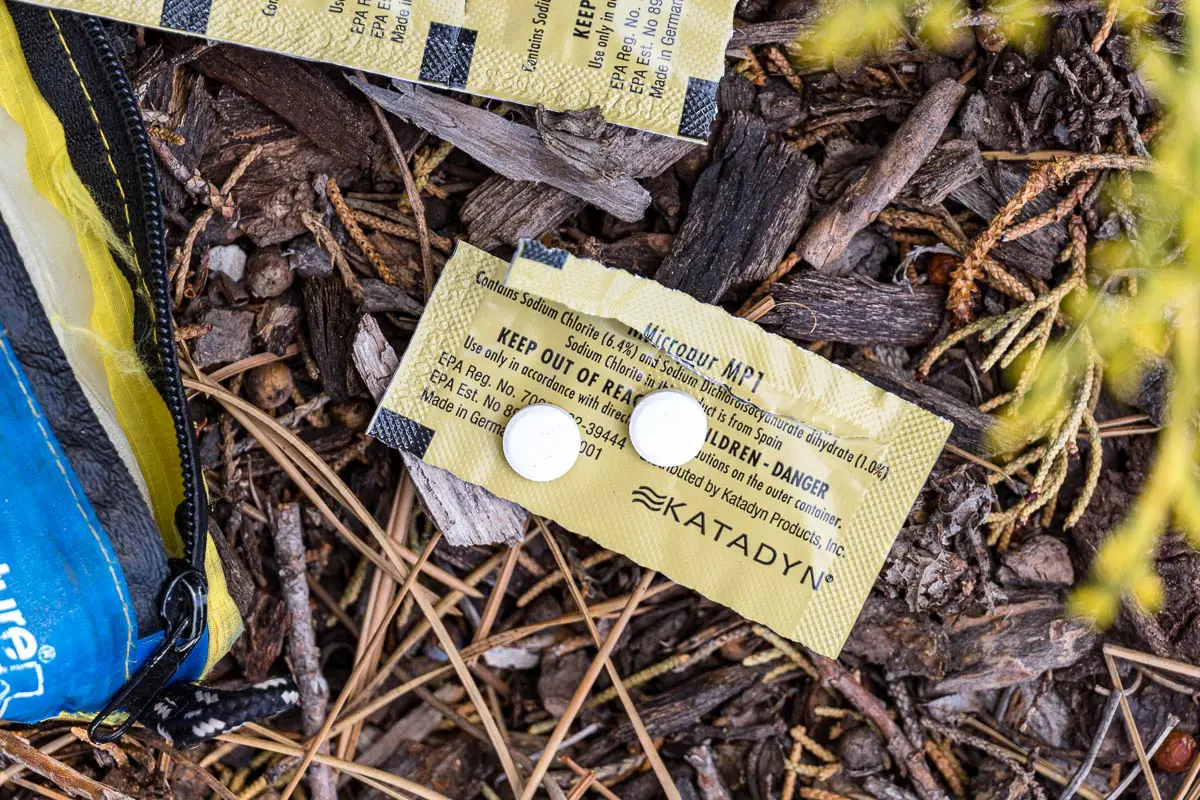
Chemical
Chemical purifiers like Aquamira drops and Micropur tablets contain chlorine dioxide, which, given enough time, destroy bacteria, protozoa, and viruses. Iodine is another chemical treatment available, but it does not kill all protozoa (namely Cryptosporidium). Chemical treatments are usually used as backups, though some opt to use them for their primary treatment method.
What about boiling?
Boiling water is always a purification option, and will kill bacteria, protozoa, and viruses. This may be your best option to purify your water if you’re camping in freezing conditions as many filters can’t withstand being frozen.
If you’re going to use this method to purify water, bring water to a rolling boil for one minute at elevations below 5,000 feet or three minutes for elevations about 5,000 feet (per the EPA). Be sure to pack along extra fuel if this is going to be your primary purification method.
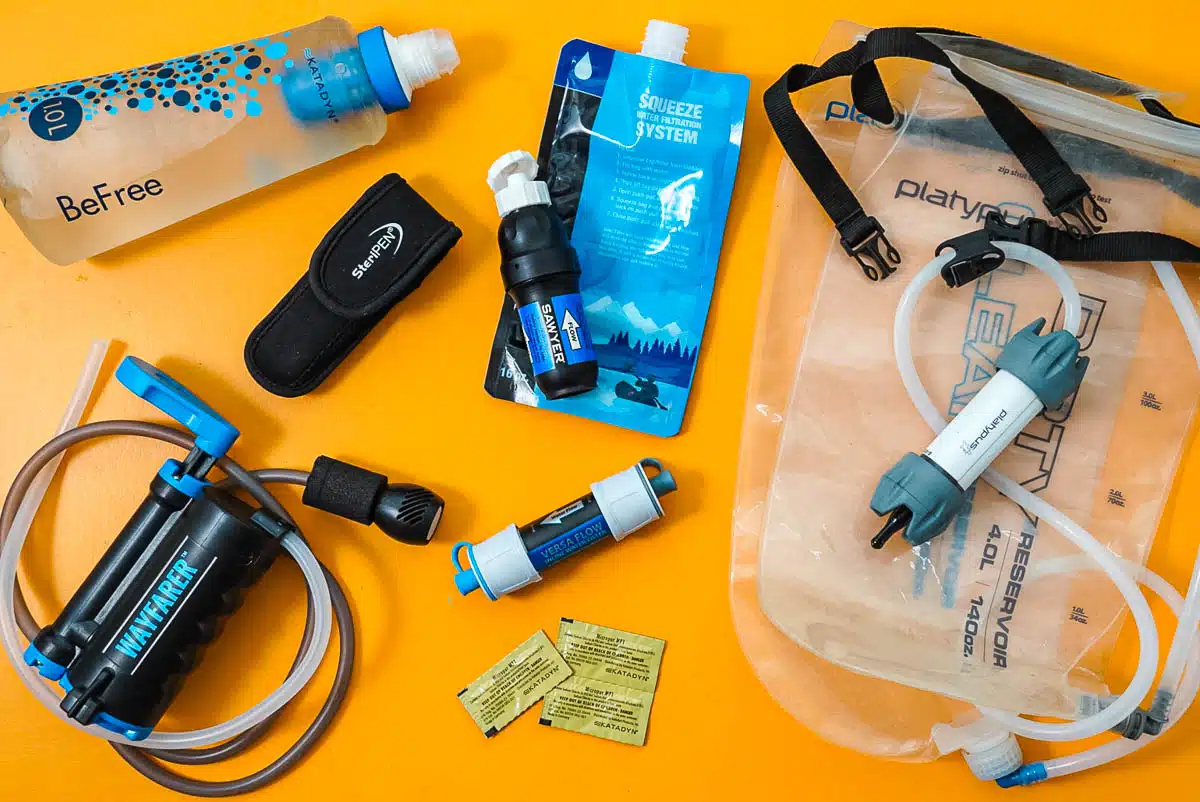
Features & buyer considerations
In addition to different methods of filtration, there are many different water filter design features to consider as well. Here are a few of the major features to consider when choosing a filter or purifier.
Ease of use
First and foremost, it’s important to consider ease of use when choosing a water filter for backpacking and hiking. If a filter is difficult to use, you’re likely to filter less and in turn decrease your water consumption, increasing your risk of dehydration. For individuals, quick or no set-up filters like the BeFree, Versa Flow, and the Sawyer Squeeze are likely to be easiest to use. For groups, a larger capacity gravity filter like the Platypus GravityWorks will make quick work of filtering water for the group despite the set-up time.
Speed / Flow Rate
If you’re trying to get miles under your feet, or get away from your water source ASAP before you get devoured by mosquitoes, the speed at which you can filter water will be an important factor. For squeeze, pump, and gravity filters, look at the “flow rate” to compare the speed of various models.
However, use this metric with a grain of salt—flow rate can change over time (for example, we’ve found that the Sawyer Squeeze, BeFree, and the Versa Flow all have similar flow rates in real-world conditions, despite their differing claimed flow rates).
Weight
Weight, of course, is always a concern to backpackers. Luckily, there are lots of lightweight options, though they do usually come with some tradeoff in the durability or convenience departments (if you’ve ever tried to fill a Sawyer Squeeze bag in a slow-moving creek you’ll know what I mean). A filter system like the GravityWorks is heavier but comes with perks like a large capacity bladder and easy field maintenance.
Lifespan
Filter lifespan is something to consider, but unless you’re thru-hiking the PCT, you aren’t going to hit the lifespan of most filters very quickly. But, you will want to keep in mind that for most filters, you will need to purchase a replacement filter or replace the system entirely at some point.
Available water sources
What types of water sources will you have available to you on your hike and how frequently will you come across them? Some filters work best with flowing or deeper water sources (like the BeFree, Sawyer Squeeze, and GravityWorks), while others like pump filters will still work well in shallow and still sources.
If you’re going to be using sketchy water sources (we see you, PCT & CDTers) you may want a filter or purifier that does a good job of filtering out organic matter, bad tastes, and chemicals. HydroBlu makes an activated carbon filter that can be added onto the Versa Flow that that will filter out heavy metals, pesticides, and other chemicals. The LifeSaver Wayfarer also has a replaceable carbon filter that will do the same.
If you’re going to have to hike miles between sources, you won’t want to choose a system that limits your capacity—or, have extra storage bottles available so you can load up when needed.
Field maintenance
Many hollow fiber filters, like Sawyer filters, Versa Flow, and the GravityWorks, will require you to backflush often in order to maintain its flow rate. Pump filters might require you to physically remove the filter and clean it if it begins to clog.
Freezing Temperatures
Hollow fiber filters cannot be allowed to freeze. The expansion of water in the fibers when frozen will break the filter, and it will no longer be effective in eliminating pathogens. The best way to prevent these types of filters from freezing is to keep them in your sleeping bag overnight and inside your jacket during the day.
Unfortunately, many filters have no way for you to verify whether the filter is damaged (Sawyer Squeeze, BeFree, Versa Flow), while others (GravityWorks, Wayfarer) can be tested or will shut down if the filter is damaged.
Bottle Compatibility
Some filter options require water bottles to collect water before treating, so you’ll want to keep that in mind when purchasing bottles to make sure that they will be compatible with your chosen filter.
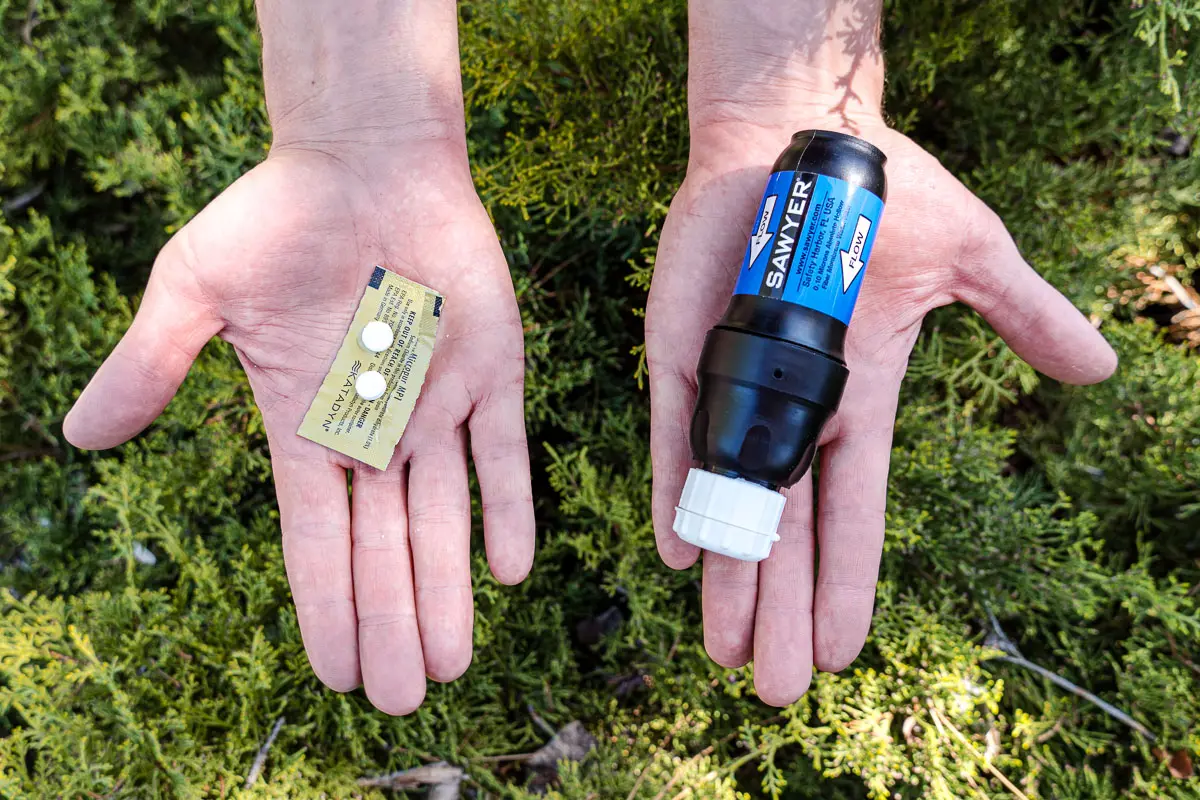
Primary water filter / secondary water purification
With a function as important as water filtration, we highly recommend that you carry a backup just in case of failure.
A very common setup is to have a primary water filter system (something like the Katadyn BeFree or Platypus GravityWorks) but also carry a chemical water purification option (like the Micropur Tablets).
You will normally only use the filter because it’s quicker, removes cloudiness and sediment, and doesn’t adversely affect the taste of the water. But if that primary filter happens to fail for some reason, you can switch to the backup system.
Those Micropur tablets are super lightweight, so it’s not really a bother to carry them around just in case. But they do take longer, don’t remove cloudiness, and add a somewhat strange taste to the water. Not ideal, but they will work in a pinch.


